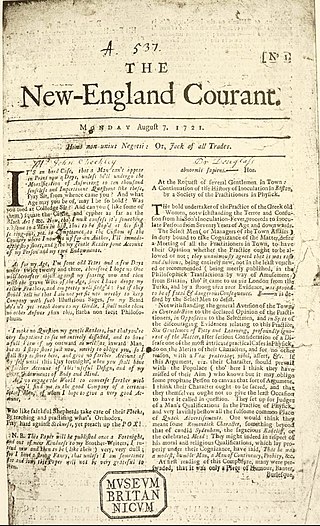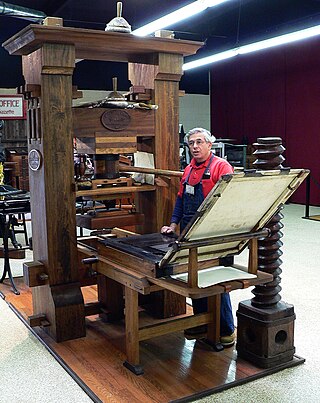
Printing is a process for mass reproducing text and images using a master form or template. The earliest non-paper products involving printing include cylinder seals and objects such as the Cyrus Cylinder and the Cylinders of Nabonidus. The earliest known form of printing as applied to paper was woodblock printing, which appeared in China before 220 AD for cloth printing. However, it would not be applied to paper until the seventh century. Later developments in printing technology include the movable type invented by Bi Sheng around 1040 AD and the printing press invented by Johannes Gutenberg in the 15th century. The technology of printing played a key role in the development of the Renaissance and the Scientific Revolution and laid the material basis for the modern knowledge-based economy and the spread of learning to the masses.

Inkjet printing is a type of computer printing that recreates a digital image by propelling droplets of ink onto paper and plastic substrates. Inkjet printers were the most commonly used type of printer in 2008, and range from small inexpensive consumer models to expensive professional machines. By 2019, laser printers outsold inkjet printers by nearly a 2:1 ratio, 9.6% vs 5.1% of all computer peripherals.

William Bradford was an early American colonial printer and publisher in British America. Bradford is best known for establishing the first printing press in the Middle colonies of the Thirteen Colonies, founding the first press in Pennsylvania in 1685 and the first press in New York in 1693. Bradford operated continuously printing establishments for sixty-two years, heading a family that would include printers and publishers for 140 years. He was also known for controversies regarding freedom of the press. Starting his printing career in London, Bradford emigrated to America in 1685. He established, with others, the first paper mill to appear in the Thirteen American Colonies.

The Wapping dispute was a lengthy failed strike by print workers in London in 1986.

Letterpress printing is a technique of relief printing for producing many copies by repeated direct impression of an inked, raised surface against individual sheets of paper or a continuous roll of paper. A worker composes and locks movable type into the "bed" or "chase" of a press, inks it, and presses paper against it to transfer the ink from the type, which creates an impression on the paper.

A wedding invitation is a letter asking the recipient to attend a wedding. It is typically written in the formal, third-person language and mailed five to eight weeks before the wedding date.

A printer's devil was a young apprentice in a printing establishment who performed a number of tasks, such as mixing tubs of ink and fetching type. Notable writers including Benjamin Franklin, Walt Whitman, Ambrose Bierce, Bret Harte, and Mark Twain served as printer's devils in their youth.

Daniel Fowle was a colonial American printer and publisher before and during the American Revolution, and the founder of The New Hampshire Gazette. He printed Samuel Adams' newspaper, The Independent Advertiser. He was jailed for printing a damaging account on the conduct of various Massachusetts representatives and after his trial, he lost his license to print. Dismayed with the Massachusetts government he subsequently chose to remove from Massachusetts to New Hampshire and established The New Hampshire Gazette. During the course of his printing career Fowle employed several apprentices. Using his newspaper, he openly criticized the Stamp Act in 1765. After American independence was established he was commissioned to print the state laws of New Hampshire.

R.R. Donnelley is an American integrated communications company that provides marketing and business communications, commercial printing, and related services. Its corporate headquarters are located in Chicago, Illinois, United States. In 2007, R.R. Donnelley was the world's largest commercial printer. In 2021, it was referred to as North America's largest.

The Sydney Gazette and New South Wales Advertiser was the first newspaper printed in Australia, running from 5 March 1803 until 20 October 1842. It was a semi-official publication of the government of New South Wales, authorised by Governor King and printed by George Howe. On 14 October 1824, under the editorship of Robert Howe, it ceased to be censored by the colonial government.

Solid ink is a type of ink used in printing. Solid ink is a waxy resin-based polymer that must be melted prior to usage unlike conventional liquid inks. The technology is used most in graphics and large format printing environments where color vividness and cost efficiency are important.
John Bushell was the first printer in what is now Canada.

The history of printing starts as early as 3000 BCE, when the proto-Elamite and Sumerian civilizations used cylinder seals to certify documents written in clay tablets. Other early forms include block seals, hammered coinage, pottery imprints, and cloth printing. Initially a method of printing patterns on cloth such as silk, woodblock printing for texts on paper originated in China by the 7th century during the Tang dynasty, leading to the spread of book production and woodblock printing in other parts of Asia such as Korea and Japan. The Chinese Buddhist Diamond Sutra, printed by woodblock on 11 May 868, is the earliest known printed book with a precise publishing date. Movable type was invented by Chinese artisan Bi Sheng in the 11th century during the Song dynasty, but it received limited use compared to woodblock printing. Nevertheless, the technology spread outside China, as the oldest printed book using metal movable type was the Jikji, printed in Korea in 1377 during the Goryeo era.
William Stansby (1572–1638) was a London printer and publisher of the Jacobean and Caroline eras, working under his own name from 1610. One of the most prolific printers of his time, Stansby is best remembered for publishing the landmark first folio collection of the works of Ben Jonson in 1616.

The New-England Courant, one of the first American newspapers, was founded in Boston in 1721, by James Franklin. It was a weekly newspaper and the third to appear in Boston. Unlike other newspapers, it offered a more critical account about the British colonial government and other royal figures of authority. The newspaper published critical commentary about smallpox inoculation which fueled the controversy during the smallpox epidemic in Boston. Ultimately it was suppressed in 1726 by British colonial authorities for printing what they considered seditious articles. Franklin took on his brother, Benjamin Franklin, as an apprentice and at one point was compelled to sign over publication of the Courant to him to avert further prosecution. Benjamin submitted anonymous editorials to the Courant, which resulted in James' imprisonment after he began publishing them.This sort of Governmental censorship of early colonial newspapers is what largely fostered the American ideal of Freedom of Speech in the press. The New England Courant is widely noted among historians as being the first newspaper to publish Benjamin's writings.
James Franklin was an early American printer, publisher and author of newspapers and almanacs in the American colonies. James published the New England Courant, one of the oldest and the first truly independent American newspapers, and the short lived Rhode Island Gazette.
The Kentish Post: or the Canterbury News-Letter, Canterbury's first newspaper, published between 1717 and 1768, is the predecessor of the present-day Kentish Gazette.

Gale and Polden was a British printer and publisher. Founded in Brompton, near Chatham, Kent in 1868, the business subsequently moved to Aldershot, where they were based until closure in November 1981 after the company had been bought by media mogul Robert Maxwell.

The International Printing Museum, has one of the largest collections of antique printing presses in the United States. It offers educational programs for school groups at the museum, and also has a Ben-Franklin-type printing press on a trailer that travels to schools and public events for living history programs.
Lakeside Press was a Chicago publishing imprint under which the RR Donnelley Company produced fine books as well as mail order catalogs, telephone directories, encyclopedias, and advertising. The Press was best known for its high quality editions for the Chicago Caxton Club as well as the Lakeside Classics, a series of fine reprints.
















